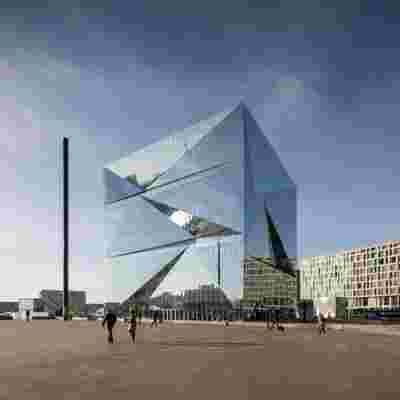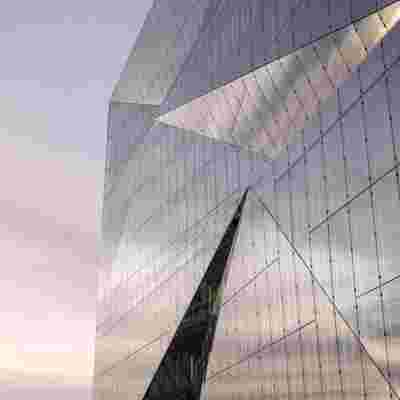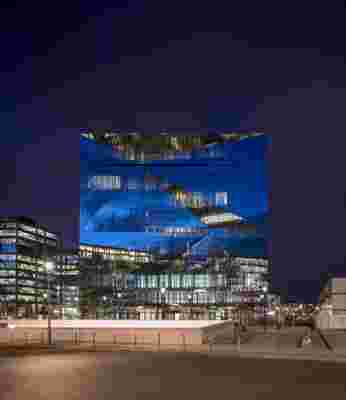Rising from Berlin’s Washington Platz like the monolith in 2001: A Space Odyssey, Cube Berlin, designed by Danish architecture firm 3XN , is the city’s newest office—and its most forward-thinking. Despite Cube Berlin’s opening its doors to tenants just last month (a move that was abruptly halted due to the coronavirus), its plans were laid quite a while back, a few years before the turn of the millennium. “The cubic shape derives from a master plan dating 25 years back by German architect O.M. Ungers for Washington Platz and the surroundings,” says Kim Herforth Nielsen, founder and creative director of 3XN. “The basic idea behind the master plan was that a solitaire building on the square should contribute to it with a sculptural or artistic gesture that would animate Washington Platz.”
As its name suggests, the building is shaped like a fractured cube, designed as such to not only reflect passersby and the sky, but also provide terraces for the offices inside. Its impressive innovations, however, are first in its inventive glazed double-skin façade and second in its “digital brain.”

The glazed double-skin façade is surprisingly sustainable.
“Cube Berlin refutes the common conception that glazed buildings are unsustainable,” says Torben Østergaard, the partner at 3XN in charge of the project. In most glazed buildings, the greenhouse effect can wreak havoc on a building’s efficiency when it comes to climate control, but thanks to the double skin, that issue is negated. “Cube Berlin pioneers the development of solar control in the outer skin rather than on the inner,” says Østergaard. “This offers more positive effects, like manageable temperatures in the cavity that imply extended seasons for natural ventilation in offices.” Through its façade and other mechanical systems like solar collectors, Cube Berlin is 25 percent more energy efficient than standard “green” buildings.

The structure’s interior is controlled by a “digital brain” that maximizes the efficiency of the building’s systems.
As for the digital brain, the entire building is managed by a single system—one that’s accessible to Cube Berlin tenants via an app. Thus, users are able to change the temperature in their office, check the charge on their electric car or bike in the garage, or even communicate with colleagues. All of the data gleaned from the app is then processed by the building’s “digital brain,” which learns the habits of the building’s occupants and adjusts its systems to maximize efficiency. “The connectivity of all systems in one integrated solution enables the exchange of data between systems otherwise operating in isolation,” says Østergaard. “The data produced during everyday operation of access control, lift operation, ventilation systems, cooling systems, etc., has now been made accessible to the common platform. Over time, new elements and features can be added to this platform so it can grow to embrace new ideas and requirements.”

The exterior takes on a different tone at night, with blue lighting covering parts of the building.
While we hope that Cube Berlin’s digital brain doesn’t follow in Hal 9000’s footsteps (from the 2001: A Space Odyssey ), we do hope it paves the way for using smart tech in offices to promote a greener future in building management. With that in mind, when the world eventually learns from and moves past the catastrophe that is COVID-19, it will be interesting to monitor if Cube Berlin’s interior is altered in any way as an adjustment to the new world we will find ourselves in.
